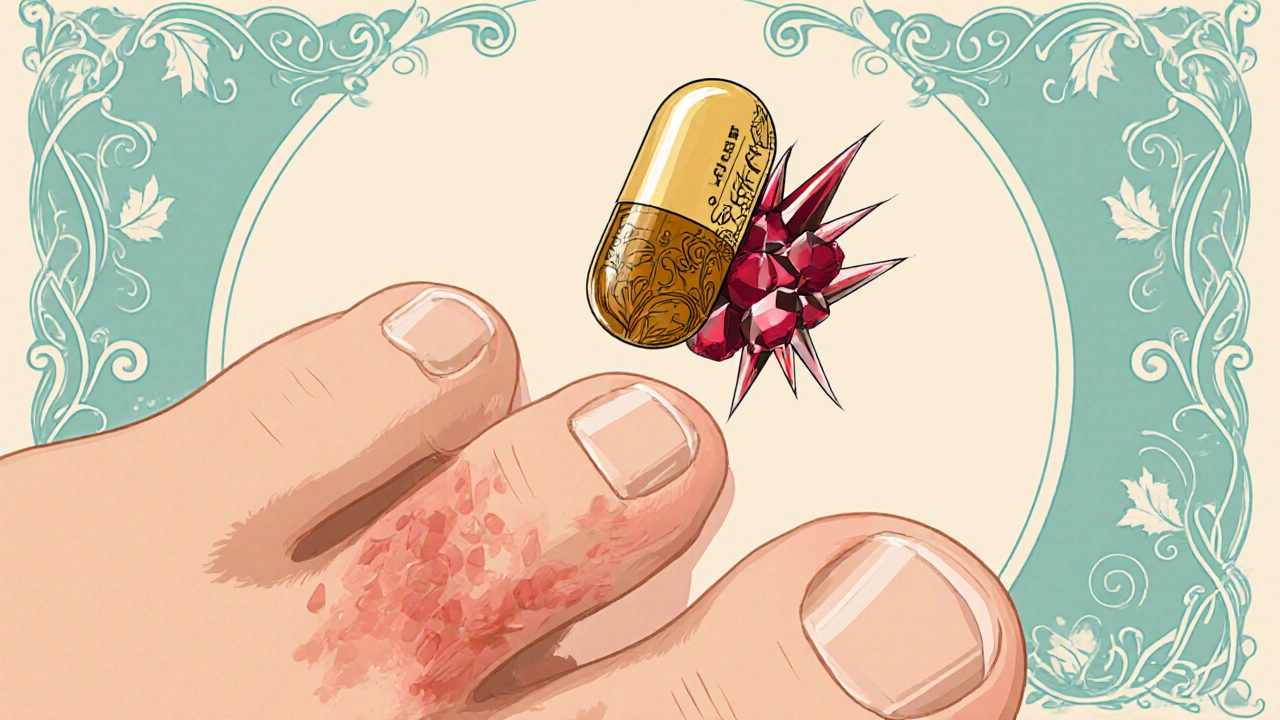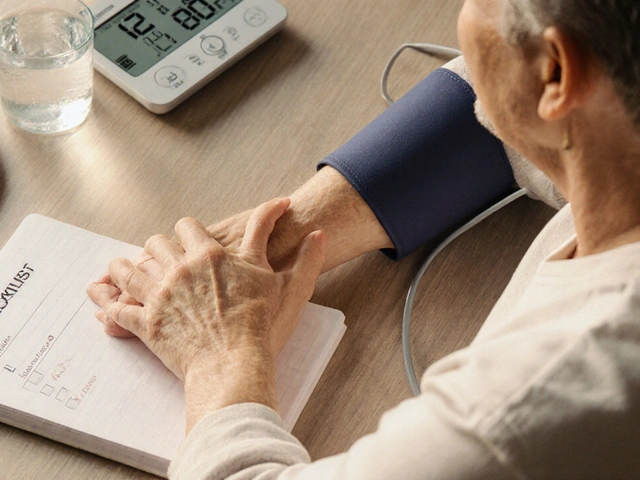Thiazide Diuretic Gout Risk Calculator
Your Estimated Gout Risk
Uric Acid Projection
With your thiazide regimen, your estimated uric acid level after will be mg/dL.
Recommended Actions
Quick Takeaways
- Thiazide diuretics can raise serum uric acid by 6‑21% and increase gout risk, especially after 3‑6 months of use.
- Monitoring uric acid before and during therapy cuts the chance of a painful gout flare.
- Choosing alternatives such as losartan, calcium‑channel blockers, or potassium‑sparing diuretics can avoid the problem.
- If a thiazide is unavoidable, low‑dose allopurinol or lifestyle tweaks (less alcohol, fewer purine‑rich foods) help keep uric acid below 6 mg/dL.
- Discontinuing the thiazide usually normalises uric acid within 2‑3 months.
If you’ve ever been told to take a thiazide diuretics is a class of low‑cost antihypertensive that works by blocking sodium reabsorption in the kidney’s distal convoluted tubule. They’re great at lowering blood pressure, but they have a notorious side‑effect: a rise in uric acid that can trigger gout. For anyone who’s already had a gout attack or carries high uric acid levels, that extra risk is a serious concern.
To understand why, we first need a clear picture of Gout is an inflammatory arthritis caused by urate crystal deposition in joints, most famously in the big toe. When serum uric acid climbs above its solubility threshold (≈6.8 mg/dL), crystals form and provoke sudden, excruciating pain. The link between thiazides and gout isn’t a myth-it’s backed by decades of epidemiology and molecular studies.
How Thiazides Raise Uric Acid
The key players are two transport proteins in the proximal tubule: Organic anion transporter 1 (OAT1) shuttles organic anions from the blood into the tubular cell. When a thiazide molecule (most commonly Hydrochlorothiazide is the prototypical agent enters the cell, it competes with urate for OAT1 binding. This competition reduces urate’s exit into the urine, pushing more of it back into the bloodstream.
A second exchanger, OAT4, sits on the lumen‑facing side of the same tubule segment. Thiazides trade places with urate across OAT4, pulling urate into the cell again and keeping it from being flushed out. The net effect: a measurable uptick in serum uric acid within days of starting therapy.
Clinical trials consistently show a 6‑21 % rise from baseline, with the increase being dose‑dependent. Most patients see the bump within the first week, and the level stays elevated as long as the drug is taken.
Epidemiology: How Big Is the Gout Risk?
Population‑based data paint a clear picture. A 2017 study in *Arthritis & Rheumatology* found a 25‑30 % higher incidence of gout among new thiazide users compared with non‑users. The risk intensifies after 180 days of continuous use, with hazard ratios climbing from 1.18 (30‑day window) to 1.41 (>180 days) in a 2024 *Nature Scientific Reports* analysis.
Not all thiazides are equal, but the difference is modest. A 2019 head‑to‑head comparison of chlorthalidone versus hydrochlorothiazide showed nearly identical gout rates when doses were matched.
Importantly, only about 1‑2 % of patients on thiazides develop a full‑blown gout flare, even though 12‑15 % develop hyperuricemia. Genetics, diet, renal function, and other comorbidities decide who crosses the symptom threshold.
Who Should Be Most Concerned?
Guidelines recommend a baseline uric acid check in anyone with a history of gout or serum uric acid >7.0 mg/dL (men) / >6.0 mg/dL (women). For patients already on a thiazide, repeat testing after 2‑4 weeks can catch early spikes.
Patients with chronic kidney disease, obesity, or high‑purine diets are especially vulnerable because their kidneys already struggle to excrete urate. In these groups, the added OAT1/OAT4 blockade can tip the balance.
Alternative Blood‑Pressure Strategies
If you’re worried about gout, several antihypertensives have a neutral or even uric‑acid‑lowering effect:
- Losartan blocks the angiotensin II receptor and also inhibits URAT1, promoting urate excretion.
- Calcium‑channel blockers (amlodipine, felodipine) have no documented impact on uric acid.
- Spironolactone is a potassium‑sparing diuretic that does not raise uric acid.
The trade‑off is cost. Generic thiazides average $4 per 90‑tablet supply, while losartan and many calcium‑channel blockers run 25‑30 % higher in Medicare Part D pricing (2023 data). For many patients, the savings outweigh the gout risk, especially if the clinician adds a modest urate‑lowering regimen.
Managing Gout If a Thiazide Is Needed
When a thiazide is the best choice-say, for resistant hypertension or in a patient who can’t tolerate other agents-there are practical steps to keep gout at bay:
- Start with the lowest effective thiazide dose (e.g., 12.5 mg HCTZ).
- Check serum uric acid at baseline, then at 2 weeks and 3 months.
- If uric acid exceeds 6.0 mg/dL, initiate lifestyle changes: limit beer, red meat, and sugary drinks; increase water intake.
- Consider prophylactic Allopurinol 100 mg daily, titrating up to keep uric acid <6 mg/dL.
- Educate the patient to recognise early gout symptoms and seek prompt treatment (colchicine or NSAIDs) to avoid joint damage.
Most patients see uric acid return to baseline within 2‑3 months after stopping the thiazide, according to Mayo Clinic observations (2023). That window gives clinicians a clear timeline for re‑assessment.
Comparison of Common Antihypertensives on Uric Acid
| Drug class | Typical effect on serum uric acid | Gout risk (relative) | Key pros / cons |
|---|---|---|---|
| Thiazide diuretics (HCTZ, chlorthalidone) | +6‑21 % | 1.3‑1.4× | Low cost, strong BP control; watch uric acid. |
| Loop diuretics (furosemide) | +10‑25 % | ~1.5× | Useful in heart failure; higher gout risk. |
| Losartan (ARB) | ‑5‑10 % | ↓ (protective) | Urate‑lowering; cost higher than generic thiazide. |
| Calcium‑channel blockers | Neutral | Baseline | Well tolerated; no uric‑acid effect. |
| Spironolactone (K‑sparing) | Neutral | Baseline | Potassium‑sparing; useful in resistant HTN. |

Practical Monitoring Checklist
- Baseline: blood pressure, serum uric acid, renal function, electrolytes.
- 2‑week follow‑up: repeat uric acid and electrolytes.
- 3‑month review: assess BP control, uric acid trend, need for dose adjustment.
- Whenever symptoms arise: check joint exam, consider NSAIDs or colchicine.
- Annual: re‑evaluate cardiovascular risk profile and gout status.
Future Directions
Researchers are testing new sodium‑chloride cotransporter inhibitors that avoid OAT1/OAT4 interaction. A phase II trial (NCT04892105) launched in 2023 aims to deliver blood‑pressure reduction without the uric‑acid spike. Results expected late 2025 could shift prescribing habits if successful.
Bottom Line
Thiazide diuretics are inexpensive, effective, and first‑line for most patients with hypertension. The trade‑off is a modest but real increase in uric acid that can provoke gout in susceptible individuals. By screening for hyperuricemia, choosing alternatives when appropriate, and managing uric acid proactively, clinicians can keep the benefits of thiazides while sidestepping painful gout attacks.
Can I stop my thiazide if I develop gout?
If gout flares become frequent, switching to a urate‑neutral agent (like losartan or a calcium‑channel blocker) is usually the first step. Discontinuing the thiazide often brings uric acid back to baseline within 2-3 months, but do it under doctor supervision to maintain blood‑pressure control.
How quickly does thiazide‑induced hyperuricemia appear?
Serum uric acid can rise within 3-7 days after the first dose, especially at higher daily amounts (≥25 mg HCTZ). Routine labs at 2 weeks catch most early spikes.
Is allopurinol safe to start alongside a thiazide?
Yes, at a low dose (100 mg daily) it safely lowers uric acid without affecting blood‑pressure control. Dose‑adjust for renal function and monitor for hypersensitivity.
Do lifestyle changes really matter for thiazide‑related gout?
Absolutely. Reducing alcohol, especially beer, cutting back on red meat and seafood, and staying well‑hydrated can keep uric acid below the crystal‑formation threshold, even when a thiazide is in use.
Are there any blood‑test markers besides uric acid I should watch?
Check electrolytes (especially potassium) and renal function (creatinine, eGFR) because thiazides can cause hyponatremia or worsen kidney disease, which in turn influences uric‑acid handling.







ahmed ali
October 26, 2025 AT 15:17Okay, before anyone jumps on the hype train about thiazides being the villain of hypertension, let’s dissect the whole mechanism with the depth it deserves. The OAT1 and OAT4 transporters aren’t just random gatekeepers; they are finely tuned exchangers that balance urate flux across the proximal tubule, and when you shove a thiazide molecule into the mix, you’re basically putting a roadblock on a highway that’s already congested with purines. First, the thiazide competes with urate for OAT1 binding, which means less urate gets secreted into the lumen
-that’s a direct cause of serum uric acid climbing. Second, OAT4 on the luminal side swaps places with urate, pulling it back into the cell and keeping it from being flushed out, a subtle yet potent double‑hit. This isn’t some myth spun by pharmaceutical ads; the molecular data show a measurable uptick within days, and clinically you see a 6‑21 % rise, dose‑dependent, often plateauing after a few weeks. Yet, the narrative that thiazides *always* cause gout is an over‑simplification, because the absolute risk hovers around 1‑2 % for full‑blown flares, meaning most patients never feel a gouty sting. You also have to factor in genetics: certain URAT1 polymorphisms amplify the effect, and dietary purine load can tip the scale even further. While alternatives like losartan or calcium‑channel blockers have a neutral uric‑acid profile, they come with their own cost and side‑effect considerations, so dismissing thiazides out‑right ignores the broader therapeutic landscape. If a patient can tolerate a low dose and you monitor uric acid periodically, you can often prevent the flare by adjusting lifestyle or adding a modest allopurinol dose. In short, thiazides are a double‑edged sword: they’re cheap, effective, and well‑studied, but they demand vigilance when the patient’s uric acid baseline is already high. So before you brand them as the enemy, weigh the evidence, consider the patient’s whole risk profile, and remember that medicine is seldom black‑and‑white.
Deanna Williamson
November 11, 2025 AT 13:06The data you’ve presented is thorough, yet it omits a crucial variable: adherence rates in real‑world settings. Many patients discontinue thiazides before the 180‑day mark precisely because of side effects, which skews the observed hazard ratios downward. Moreover, the cited 25‑30 % relative increase in gout incidence fails to contextualize absolute numbers; a 0.3 % absolute rise may be clinically negligible for a population with low baseline risk. Finally, the recommendation to pre‑emptively start allopurinol ignores the potential for drug‑drug interactions and unnecessary exposure in patients who would never develop hyperuricemia.
Carolyn Cameron
November 27, 2025 AT 10:55Whilst the aforementioned exposition delineates the pharmacodynamic intricacies of thiazide‑induced hyperuricemia, it behooves the practitioner to appraise the cost‑benefit equilibrium within the broader therapeutic algorithm, acknowledging both fiscal constraints and the patient's comorbid tableau.
Samantha Taylor
December 13, 2025 AT 08:44Indeed, one might conclude that prescribing a thiazide without concomitant uric‑acid monitoring is tantamount to inviting a gout attack with open arms-an approach that, while seemingly bold, borders on the reckless in contemporary practice.